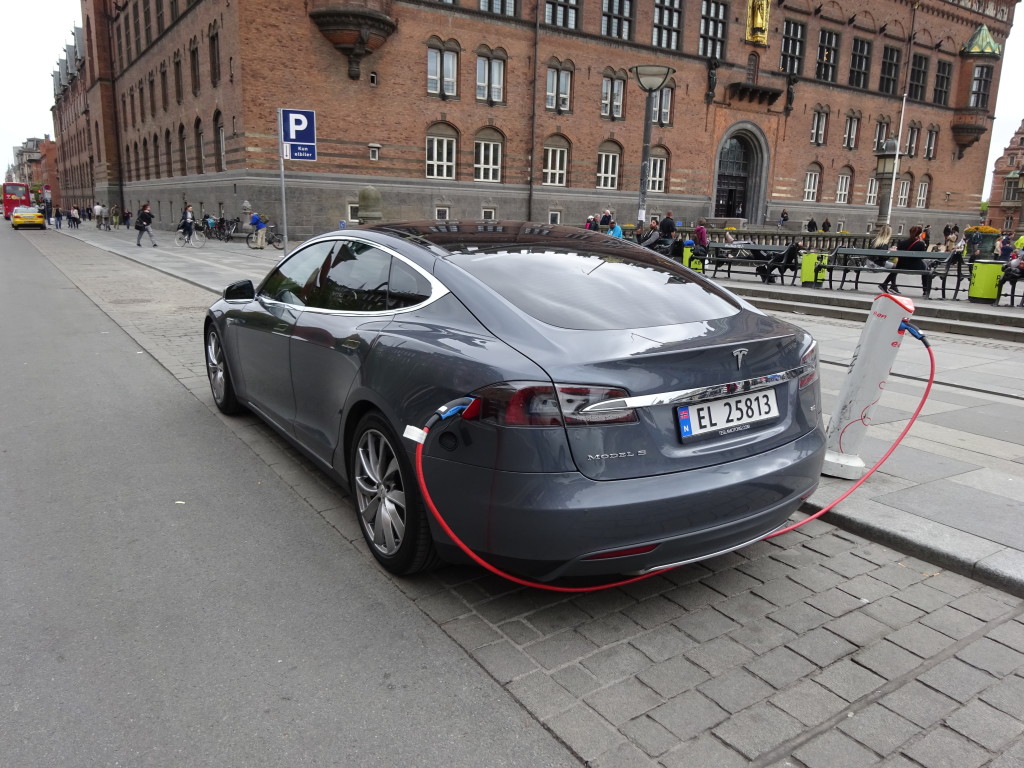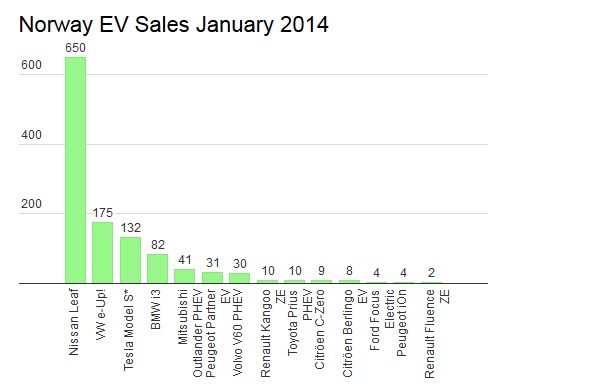More and more I see electric cars around the United States, mostly the obvious ones like the Tesla Model S and an occasional plug-in hybrid like the Chevy Volt, plus the obvious non-plug-in hybrids like Toyota Prius. But this pales to the number of electric cars that I saw in Norway, Denmark, and Sweden. One reason – access to charging stations.

Elon Musk has been working hard to install charging stations throughout the major driving corridors of the US. The government has not been all that helpful in that regard; in fact, because of oil and auto manufacturer lobbying (and Congress’s inability to function), our government inaction still works against the widespread distribution of electric cars. Europe has taken the opposite approach.

In Copenhagen, there were a couple of charging stations right next to the famed city hall. In Stockholm, charging stations were also present, while in Oslo they have put a huge focus on electric vehicles. The photo above shows charging stations lined up and down both sides of the street. Interestingly, this particular spot was up against the old stone fortress walls made so famous in Jo Nesbo books. It shows that the old and new are compatible.

While it was nice to see so many Tesla Model S cars, the predominant electric vehicle (EV) was actually the Nissan Leaf. According to Clean Technica, the Leaf has grabbed a huge lead in market share in Norway. The graphic above shows that Leaf sales made up 55% of the total EV sales in January 2014, almost four times the next electric car (Volkswagen’s e-Up!) and almost five times the Tesla Model S. Fully electric vehicles (EVs) dwarfed the number of plug-in hybrid electric vehicles (PHEVs) in Norway (and in Denmark, where 100% of EVs were full plug-ins). Oddly enough, PHEVs were ahead of full EVs in Sweden, in part because of the popularity of Mitsubishi’s Outlander PHEV and the lack of availability of the Tesla Model S.
Besides the greater environmental awareness of Scandinavians compared to Americans, drivers in Sweden, Denmark, and Norway already have access to the type of electrical sockets needed for EVs. These countries also offer much better financial incentives to help drivers move away from fossil fuel based engines to more sustainable engine technology. They have also done a better job at facilitating charging stations, most of which are free to the public.
As you’ll see in that last link, charging stations for EVs and PHEVs are starting to appear in more and more places in the US as well, which should mean faster adoption of electric and hybrid vehicles in the near future. Eventually, all our vehicles may be EVs. That would go a long way to reducing our dependence on oil-based energy and our contributions to man-made climate change.
I’ll have more science traveling updates from Scandinavia, as well as from the Everglades, Yosemite, Argentina, and the other places I’ve visited since I embarked on this new career. Stay tuned (and feel free to wander around previous posts by clicking on “Travel” in the category list below).
David J. Kent has been a scientist for over thirty years, is an avid science traveler, and an independent Abraham Lincoln historian. He is the author of Tesla: The Wizard of Electricity and the e-book Nikola Tesla: Renewable Energy Ahead of Its Time. He is currently writing a book on Thomas Edison.
Follow me by subscribing by email on the home page. And feel free to “Like” my Facebook author’s page and connect on LinkedIn. Share with your friends using the buttons below.











As you’re probably already aware, Tesla’s “Gigafactory 1” is under construction about 50-miles from here. Apparently, Panasonic is also sending over several hundred people to study and coordinate operations (I’ve already met some of the vanguard). “Gigafactory 2” in Japan, perhaps?
I’ve been waiting for the Model X. I didn’t realize until Tesla was up at the local hotel with a Model S-P85D a few weeks ago that we actually have three charging stations here in town — at the golf course,at the ski area, and at the hotel. A couple of towns over, along the Interstate, there’s also a high-power station. It never occurred to me before, but these charging stations can be incentives for travelers, visitors and tourists to patronize businesses.
Elon Musk certainly is someone forward-thinking. His influence has almost singlehandedly ushered in the future EV era. I’m still waiting for him to give me a Tesla car (after all, I sent him my Tesla book).
I think the charging stations are critical. Imagine starting a cross-country trip in your gasoline powered car without knowing if you’ll ever find a gas station. And I agree with you about the incentives for businesses; I’ve started to see places like parking garages in DC advertise that they offer EV charging stations.
I think the batteries are the key. For an EV owner, they presently amount to a large investment in a component that will inevitably deteriorate with use. And that said, Gigafactory production could be a game-changer.
Tesla’s (and some other EV’s) were designed to support “hot-swappable” battery-packs that can be removed and replaced by a robot beneath the car in about 90-seconds. Kind of like exchanging a welding-gas cylinder — you only buy (or lease) a cylinder once, and then just swap it for a pre-filled cylinder when the need arises, paying (mainly) for just the contents.
I know that the company, Better Place, tried to set up hot-swap stations that worked with some Nissans. But without enough cars on the road to utilize the technology, the economics won’t support the infrastructural investment. With the mass-production of batteries, however, that could be changing.
If production can exceed immediate demand and battery costs drop, it will allow for the accumulation of fueling-station inventories. And once there are enough vehicles to support hot-swap stations every few-hundred miles along some major Interstates, range becomes significantly less of an issue when considering the purchase of a vehicle. And even if an EV owner only rarely uses the stations, it still resolves that long-term battery maintenance issue.
Good points. Battery life will still drive the sales because people want to be able to make long road trips. Even if they install charging stations where we currently have gas stations, the charging time will mean long waits for a few “pumps.”
Hot-swaps are a step toward extending distances, and if it’s done in 90-seconds that will beat the time to refill a gas tank. It will be interesting to see how it will develop, but as you note, the economics for a private company aren’t favorable. That’s true for all new technologies, which is why the government has historically subsidized them to give them a chance. We did that for oil, and still do it for oil, whose incredibly powerful (and rich) lobbies are why it’s been so difficult for us to shift more swiftly to renewable technologies.